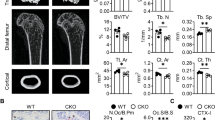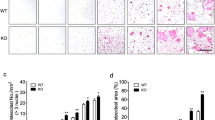Abstract
Advanced glycation end products (AGEs) aggregation and macrophages polarization are identified as the main factors contributing to bone diseases caused by aging or diabetes, such as senile or diabetic osteoporosis. Here, we aimed to elucidate the involvement and potential mechanism of AGEs in macrophages polarization and osteoclastogenesis. Firstly, AGEs-treated RAW264.7 macrophages were observed to up-regulate the release of nitric oxide (NO), the expression of M1-associated genes and the surface antigen marker CD86. The detection of osteoclast-related markers and TRAP staining revealed that the osteoclastogenic ability of M1 macrophages was markedly enhanced by AGEs. Further, AGEs were found to effectively activate the transduction of Notch signaling pathway and promote the nuclear translocation of NICD1. In addition, with the signals transduction of Notch pathway blocked by γ-secretase inhibitor DAPT and siRNA targeting silencing RBP-J, AGEs-induced M1 polarization was significantly mitigated. Collectively, we defined a critical role for AGEs in inducing M1 polarization and osteoclastogenesis of macrophages, and further identified Notch/NICD/RBP-J signaling axis as an essential mechanism regulating AGEs-mediated M1 polarization.






Similar content being viewed by others
Data availability statement
The datasets generated and analyzed during the current study are available from the corresponding author on reasonable request.
References
Chaudhuri J, Bains Y, Guha S, Kahn A, Hall D, Bose N, Gugliucci A and Kapahi P (2018) The Role of Advanced Glycation End Products in Aging and Metabolic Diseases: Bridging Association and Causality. Cell Metab 28:337–352. doi: https://doi.org/10.1016/j.cmet.2018.08.014
Poulsen M, Hedegaard R, Andersen J, de Courten B, Bügel S, Nielsen J, Skibsted L and Dragsted L (2013) Advanced glycation endproducts in food and their effects on health. Food Chem Toxicol 60:10–37. doi: https://doi.org/10.1016/j.fct.2013.06.052
Nowotny K, Jung T, Grune T and Höhn A (2014) Accumulation of modified proteins and aggregate formation in aging. Exp Gerontol 57:122 − 31. doi: https://doi.org/10.1016/j.exger.2014.05.016
Guo Y, Jia X, Cui Y, Song Y, Wang S, Geng Y, Li R, Gao W and Fu D (2021) Sirt3-mediated mitophagy regulates AGEs-induced BMSCs senescence and senile osteoporosis. Redox Biol 41:101915. doi: https://doi.org/10.1016/j.redox.2021.101915
Briceno Noriega D, Zenker H, Croes C, Ewaz A, Ruinemans-Koerts J, Savelkoul H, van Neerven R and Teodorowicz M (2022) Receptor Mediated Effects of Advanced Glycation End Products (AGEs) on Innate and Adaptative Immunity: Relevance for Food Allergy. Nutrients 14. doi: https://doi.org/10.3390/nu14020371
Glass C and Natoli G (2016) Molecular control of activation and priming in macrophages. Nat Immunol 17:26–33. doi: https://doi.org/10.1038/ni.3306
Sica A and Mantovani A (2012) Macrophage plasticity and polarization: in vivo veritas. J Clin Invest 122:787 − 95.
Murray P (2017) Macrophage Polarization. Annu Rev Physiol 79:541–566. doi: https://doi.org/10.1146/annurev-physiol-022516-034339
Boyle W, Simonet W and Lacey D (2003) Osteoclast differentiation and activation. Nature 423:337 − 42. doi: https://doi.org/10.1038/nature01658
Fukui S, Iwamoto N, Takatani A, Igawa T, Shimizu T, Umeda M, Nishino A, Horai Y, Hirai Y, Koga T, Kawashiri S, Tamai M, Ichinose K, Nakamura H, Origuchi T, Masuyama R, Kosai K, Yanagihara K and Kawakami A (2017) M1 and M2 Monocytes in Rheumatoid Arthritis: A Contribution of Imbalance of M1/M2 Monocytes to Osteoclastogenesis. Front Immunol 8:1958. doi: https://doi.org/10.3389/fimmu.2017.01958
Yao Y, Cai X, Ren F, Ye Y, Wang F, Zheng C, Qian Y and Zhang M (2021) The Macrophage-Osteoclast Axis in Osteoimmunity and Osteo-Related Diseases. Front Immunol 12:664871. doi: https://doi.org/10.3389/fimmu.2021.664871
Wang Q, Zhu G, Cao X, Dong J, Song F and Niu Y (2017) Blocking AGE-RAGE Signaling Improved Functional Disorders of Macrophages in Diabetic Wound. J Diabetes Res 2017:1428537. doi: https://doi.org/10.1155/2017/1428537
Han X, Ma W, Zhu Y, Sun X and Liu N (2020) Advanced glycation end products enhance macrophage polarization to the M1 phenotype via the HIF-1α/PDK4 pathway. Mol Cell Endocrinol 514:110878. doi: https://doi.org/10.1016/j.mce.2020.110878
Son S, Hwang I, Han S, Shin J, Shin O and Yu J (2017) Advanced glycation end products impair NLRP3 inflammasome-mediated innate immune responses in macrophages. J Biol Chem 292:20437–20448. doi: https://doi.org/10.1074/jbc.M117.806307
Yang X, Gandhi C, Rahman M, Appleford M, Sun L and Wang X (2015) Age-Related Effects of Advanced Glycation End Products (Ages) in Bone Matrix on Osteoclastic Resorption. Calcif Tissue Int 97:592–601. doi: https://doi.org/10.1007/s00223-015-0042-1
Radtke F, MacDonald H and Tacchini-Cottier F (2013) Regulation of innate and adaptive immunity by Notch. Nat Rev Immunol 13:427 − 37. doi: https://doi.org/10.1038/nri3445
Artavanis-Tsakonas S, Rand M and Lake R (1999) Notch signaling: cell fate control and signal integration in development. Science 284:770-6. doi: https://doi.org/10.1126/science.284.5415.770
Foldi J, Chung Ay Fau - Xu H, Xu H Fau - Zhu J, Zhu J Fau - Outtz HH, Outtz Hh Fau - Kitajewski J, Kitajewski J Fau - Li Y, Li Y Fau - Hu X, Hu X Fau - Ivashkiv LB and Ivashkiv LB (2010) Autoamplification of Notch signaling in macrophages by TLR-induced and RBP-J-dependent induction of Jagged1. J Immunol 185:5023–31.
Palaga T, Buranaruk C, Rengpipat S, Fauq A, Golde T, Kaufmann S and Osborne B (2008) Notch signaling is activated by TLR stimulation and regulates macrophage functions. Eur J Immunol 38:174 − 83. doi: https://doi.org/10.1002/eji.200636999
Wang Y, He F, Feng F, Liu X, Dong G, Qin H, Hu X, Zheng M, Liang L, Feng L, Liang Y and Han H (2010) Notch signaling determines the M1 versus M2 polarization of macrophages in antitumor immune responses. Cancer Res 70:4840-9. doi: https://doi.org/10.1158/0008-5472.Can-10-0269
Aalaei K, Rayner M and Sjöholm I (2019) Chemical methods and techniques to monitor early Maillard reaction in milk products; A review. Crit Rev Food Sci Nutr 59:1829–1839. doi: https://doi.org/10.1080/10408398.2018.1431202
Odegaard JI and Chawla A (2011) Alternative macrophage activation and metabolism. Annu Rev Pathol 6:275 − 97.
Nath N and Kashfi K (2020) Tumor associated macrophages and ‘NO’. Biochem Pharmacol 176:113899. doi: https://doi.org/10.1016/j.bcp.2020.113899
Cheng Y, Yang S, Wang J, Ye M, Zhuo X, Wang L, Chen H, Zhang H and Yang L (2018) Irbesartan attenuates advanced glycation end products-mediated damage in diabetes-associated osteoporosis through the AGEs/RAGE pathway. Life Sci 205:184–192. doi: https://doi.org/10.1016/j.lfs.2018.04.042
Xing Y, Pan S, Zhu L, Cui Q, Tang Z, Liu Z and Liu F (2022) Advanced Glycation End Products Induce Atherosclerosis via RAGE/TLR4 Signaling Mediated-M1 Macrophage Polarization-Dependent Vascular Smooth Muscle Cell Phenotypic Conversion. Oxid Med Cell Longev 2022:9763377. doi: https://doi.org/10.1155/2022/9763377
Shirakawa K, Endo J, Kataoka M, Katsumata Y, Yoshida N, Yamamoto T, Isobe S, Moriyama H, Goto S, Kitakata H, Hiraide T, Fukuda K and Sano M (2018) IL (Interleukin)-10-STAT3-Galectin-3 Axis Is Essential for Osteopontin-Producing Reparative Macrophage Polarization After Myocardial Infarction. Circulation 138:2021–2035. doi: https://doi.org/10.1161/circulationaha.118.035047
Li X, Yang K, Gao S, Zhao J, Liu G, Chen Y, Lin H, Zhao W, Hu Z and Xu N (2020) Carnosine Stimulates Macrophage-Mediated Clearance of Senescent Skin Cells Through Activation of the AKT2 Signaling Pathway by CD36 and RAGE. Front Pharmacol 11:593832. doi: https://doi.org/10.3389/fphar.2020.593832
He S, Hu Q, Xu X, Niu Y, Chen Y, Lu Y, Su Q and Qin L Advanced glycation end products enhance M1 macrophage polarization by activating the MAPK pathway. Biochem Biophys Res Commun 525(2):334–340.
Liu Z, Ma Y, Cui Q, Xu J, Tang Z, Wang Y, He C and Wang X (2020) Toll-like receptor 4 plays a key role in advanced glycation end products-induced M1 macrophage polarization. Biochem Biophys Res Commun 531(4):602–608.
Kopan R and Ilagan MX (2009) The canonical Notch signaling pathway: unfolding the activation mechanism. Cell 137:216 − 33.
Schroeter E, Kisslinger J and Kopan R (1998) Notch-1 signalling requires ligand-induced proteolytic release of intracellular domain. Nature 393:382-6. doi: https://doi.org/10.1038/30756
Dong Z, Huo J, Liang A, Chen J, Chen G and Liu D (2021) Gamma-Secretase Inhibitor (DAPT), a potential therapeutic target drug, caused neurotoxicity in planarian regeneration by inhibiting Notch signaling pathway. Sci Total Environ 781:146735. doi: https://doi.org/10.1016/j.scitotenv.2021.146735
Borggrefe T and Oswald F (2009) The Notch signaling pathway: transcriptional regulation at Notch target genes. Cell Mol Life Sci 66:1631-46. doi: https://doi.org/10.1007/s00018-009-8668-7
Boriushkin E, Zhang H, Becker M, Peachey J, Shatat M, Adams R and Hamik A (2019) Kruppel-like factor 4 regulates developmental angiogenesis through disruption of the RBP-J-NICD-MAML complex in intron 3 of Dll4. Angiogenesis 22:295–309. doi: https://doi.org/10.1007/s10456-018-9657-y
Chen B, Zheng M, Chen Y, Du Y, Sun X, Zhang X, Duan L, Gao F, Liang L, Qin H, Luo Z and Han H (2015) Myeloid-Specific Blockade of Notch Signaling by RBP-J Knockout Attenuates Spinal Cord Injury Accompanied by Compromised Inflammation Response in Mice. Mol Neurobiol 52:1378–1390. doi: https://doi.org/10.1007/s12035-014-8934-z
Xu H, Zhu J, Smith S, Foldi J, Zhao B, Chung A, Outtz H, Kitajewski J, Shi C, Weber S, Saftig P, Li Y, Ozato K, Blobel C, Ivashkiv L and Hu X (2012) Notch-RBP-J signaling regulates the transcription factor IRF8 to promote inflammatory macrophage polarization. Nat Immunol 13:642 − 50. doi: https://doi.org/10.1038/ni.2304
Funding
This study was supported by Program for the Natural Science Foundation of China (81470772) and the Medical Scientific Research Project of Chongqing (cstc2020jcyj-msxmX0307).
Author information
Authors and Affiliations
Contributions
All authors contributed to the study conception and design. Material preparation, data collection, and analysis were performed by Hao Tan, Xiaoqian Ding, and Leilei Zheng. The first draft of the manuscript was written by Hao Tan and all authors commented on previous versions of the manuscript. All authors read and approved the final manuscript.
Corresponding author
Ethics declarations
Conflict of interest
The authors declare that they have no conflict of interest.
Ethics approval
We declare that this study only used purchased murine cell lines and did not involve experimental animals or human participants, so no special ethical approval is required.
Additional information
Publisher’s note
Springer Nature remains neutral with regard to jurisdictional claims in published maps and institutional affiliations.
Rights and permissions
About this article
Cite this article
Tan, H., Xu, W., Ding, X. et al. Notch/NICD/RBP-J signaling axis regulates M1 polarization of macrophages mediated by advanced glycation end products. Glycoconj J 39, 487–497 (2022). https://doi.org/10.1007/s10719-022-10062-y
Received:
Revised:
Accepted:
Published:
Issue Date:
DOI: https://doi.org/10.1007/s10719-022-10062-y




